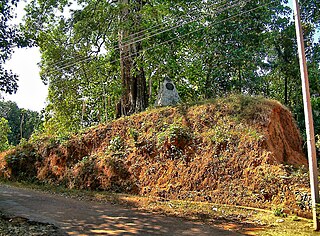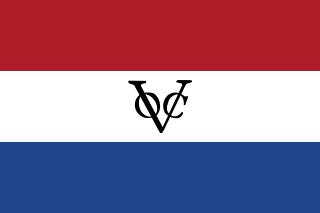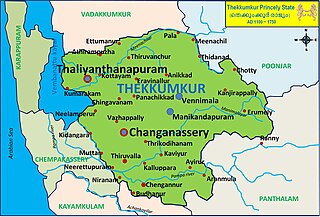
The Kingdom of Travancore, also known as the Kingdom of Thiruvithamkoor or later as Travancore State, was kingdom that lasted from c. 1729 until 1949. It was ruled by the Travancore Royal Family from Padmanabhapuram, and later Thiruvananthapuram. At its zenith, the kingdom covered most of the south of modern-day Kerala and the southernmost part of modern-day Tamil Nadu with the Thachudaya Kaimal's enclave of Irinjalakuda Koodalmanikyam temple in the neighbouring Kingdom of Cochin. However Tangasseri area of Kollam city and Anchuthengu near Attingal in Thiruvananthapuram were parts of British India.

The kingdom of Cochin, also known as the kingdom of Kochi or later as Cochin state, named after its capital in the city of Kochi (Cochin), was an Hindu kingdom in the central part of present-day Kerala state. It commenced at the early part of the 12th century and continued to rule until its accession to the Dominion of India in 1949.

Anizham Thirunal Marthanda Varma was the founding monarch of the southern Indian Kingdom of Travancore from 1729 until his death in 1758. He was succeeded by Rama Varma (1758–98).
Paliath Achan or Paliyath Achan is the name given to the oldest male member of the Paliam family, a Nair/Menon royal family from the Indian state of Kerala who ruled over Chendamangalam, Vypin, parts of Thrissur and regions that were under the erstwhile Kingdom of Villarvattom. The family had palaces and forts in these regions but their primary residence remained in Chendamangalam. The Paliath Achans were given the role of hereditary Prime ministership of the Kingdom of Cochin by the Kochi Maharajah.
Venad was a medieval kingdom lying between the Western Ghat mountains and the Arabian Sea on the south-western tip of India with its headquarters at the port city of Kollam (Quilon). It was one of the major principalities of Kerala, along with kingdoms of Kannur (Kolathunadu), Kozhikode (Nediyiruppu), and Kochi (Perumpadappu) in medieval and early modern period.

The Battle of Colachel was fought on 10 August 1741 [O.S. 31 July 1741] between the Indian kingdom of Travancore and the Dutch East India Company. During the Travancore-Dutch War, King Marthanda Varma's (1729–1758) forces defeated the Dutch East India Company's forces led by Admiral Eustachius De Lannoy on 10 August 1741. The Dutch never recovered from the defeat and no longer posed a large colonial threat to India. Travancore won the war with the notable military service of the Travancore nair brigadeat the sea and seashore while Arumukhan pilla,Nanu Pilla, Chembaka Raman Pilla these three Nair commanders in chief of the army at the land.

Rama Varma I often referred to as Dharma Raja, was the Maharajah of Travancore from 1758 until his death in 1798. He succeeded his uncle Marthanda Varma, who is credited with the title of "maker of modern Travancore". During his reign Dharma Raja not only retained all the territories his predecessor had gained but administered the kingdom with success. He was addressed as Dharma Raja on account of his strict adherence to Dharma Sastra, the Hindu principles of justice by providing asylum to thousands of Hindus and Christians fleeing Malabar during the Mysorean conquest of Malabar.

Nedumkotta or Travancore lines was a wall built as a protection against consistent invasions from Mysore during the rule of Tipu Sultan. It was built by the Dharma Raja Karthika Thirunal, King of Travancore, with the request, support and permission of the Kingdom of Kochi. It was constructed by Rama Varma under the supervision of his commander Eustachius De Lannoy. The work was started in 1762 it was completed only by 1775. The lines consist of a ditch about sixteen feet broad and twenty feet deep with a thick bamboo hedge in it, a slight parapet and good rampart and bastions on rising grounds almost flanking each other from one extreme of the lines to the other. The construction of Nedumkotta or the Travancore Lines is considered to be a unique and unparallel episode in Indian History by historians.

Velayudhan Chempakaraman Thampi ofThalakulam (1765–1809) was the Dalawa or Prime Minister of the Indian kingdom of Travancore between 1802 and 1809 during the reign of Bala Rama Varma Kulasekhara Perumal. He is best known for being one of the earliest individuals to rebel against the British East India Company's authority in India.

The Travancore–Dutch War was a war between the Dutch East India Company (VOC) and the Indian kingdom of Travancore, culminating in the Battle of Colachel in 1741. Travancore won the war with the notable military service of fishermen community at the sea and seashore while Ananthapadmanabhan nadar as commander in chief of the army at the land.

Eustachius Benedictus de Lannoy was a skilled military strategist and commander of the Travancore army, under Maharaja Marthanda Varma.

The Nair Brigade was the army of the erstwhile kingdom of Travancore in India. Nairs were a warrior community of the region. The personal bodyguard of the king Marthanda Varma (1706–1758) was also called Thiruvithamkoor Nair Pattalam. The Travancore army was officially referred as the Travancore Nair Brigade in 1818.

)Ramayyan Dalawa was the Dalawa of Travancore state, India, during 1737 and 1756 and was responsible for the consolidation and expansion of that kingdom after the defeat of the Dutch at the 1741 Battle of Colachel during the reign of Maharajah Marthanda Varma, the creator of modern Travancore.

The Battle of Nedumkotta took place between December 1789 and May 1790, and was a reason for the opening of hostilities in the Third Anglo-Mysore War. This battle was fought between Tipu Sultan of the Kingdom of Mysore and Dharma Raja, Maharaja of Travancore. Mysore army attacked the fortified line in Thrissur district at the Travancore border known as the Nedumkotta. The Mysore army was successfully repulsed by the Travancore army under the leadership of Raja Kesavadas, Dewan of Travancore.

The Mysorean invasion of Malabar (1766–1792) was the military invasion of the Malabar region of Kerala, including the territories of the Zamorin of Calicut, by the then-de facto ruler of the Kingdom of Mysore, Hyder Ali. After the invasion, the Kingdom of Cochin to the south of Malabar became a tributary state of Mysore.

The Cochin–Travancore Alliance was an alliance between the Kingdom of Cochin and the Kingdom of Travancore established in 1761 that had the goal of expelling the forces of the Zamorin of Calicut from regions of Cochin they had occupied the decade before. The alliance stipulated that the king of Travancore would help to liberate the occupied Cochinese territories in exchange for being allowed to retain the areas of Cochin they had annexed in 1755 and 1756.

Dutch Malabar also known by the name of its main settlement Cochin, were a collection of settlements and trading factories of the Dutch East India Company on the Malabar Coast between 1661 and 1795, and was a subdivision of what was collectively referred to as Dutch India. Dutch presence in the Malabar region started with the capture of Portuguese Quilon, expanded with the Conquest of Malabar (1658-1663), and ended with the conquest of Malabar by the British in 1795. They possessed military outposts in 11 locations: Alleppey, Ayacotta, Chendamangalam, Pappinivattom, Ponnani, Pallipuram, Cranganore, Chetwai, Cannanore, Cochin, and Quilon.
Parappanad was a former feudal city-state in Malabar, India. The headquarters of Parappanad Royal family was at the town Parappanangadi in present-day Malappuram district. In 1425, the country divided into Northern Parappanad and Southern Parappanad. Southern Parappanad included parts of Tirurangadi Taluk and the town Parappanangadi. Northern Parappanad included Panniyankara, Beypore, and Cheruvannur of Kozhikkode Taluk. Parappanad royal family is a cousin dynasty of the Travancore royal family.

The Battle of Changanacherry was a battle between the kingdoms of Thekkumkur and Travancore in September 1749. Defeat in this decisive battle led to Thekkumkur losing its dominance and expanding the Tranvancore empire to the southern border of the river Meenachilar.

Aditya Varma Manikandan popularly known as Aditya Varman, was the last ruling Maharaja of the Princely State of Thekkumkur. He was the ruler until September 1749 when the king of Travancore Anizham Thirunal Marthanda Varma ousted him from Neerazi Palace at the Battle of Changanassery. Thekkumkur kings were known as Manikandan. The goddess was Cheruvally Bhagavathi in the space. The official residence of Sri Aditya Varma was Neerazi Palace.













